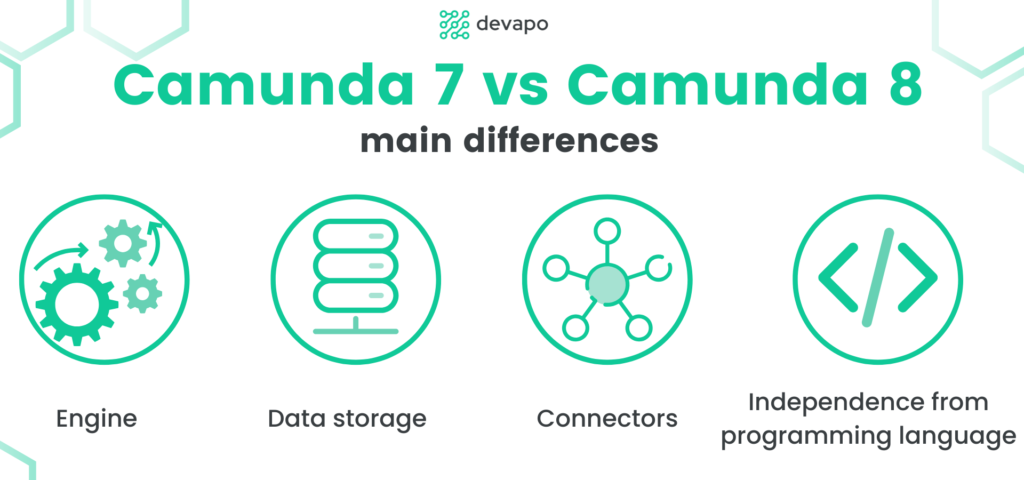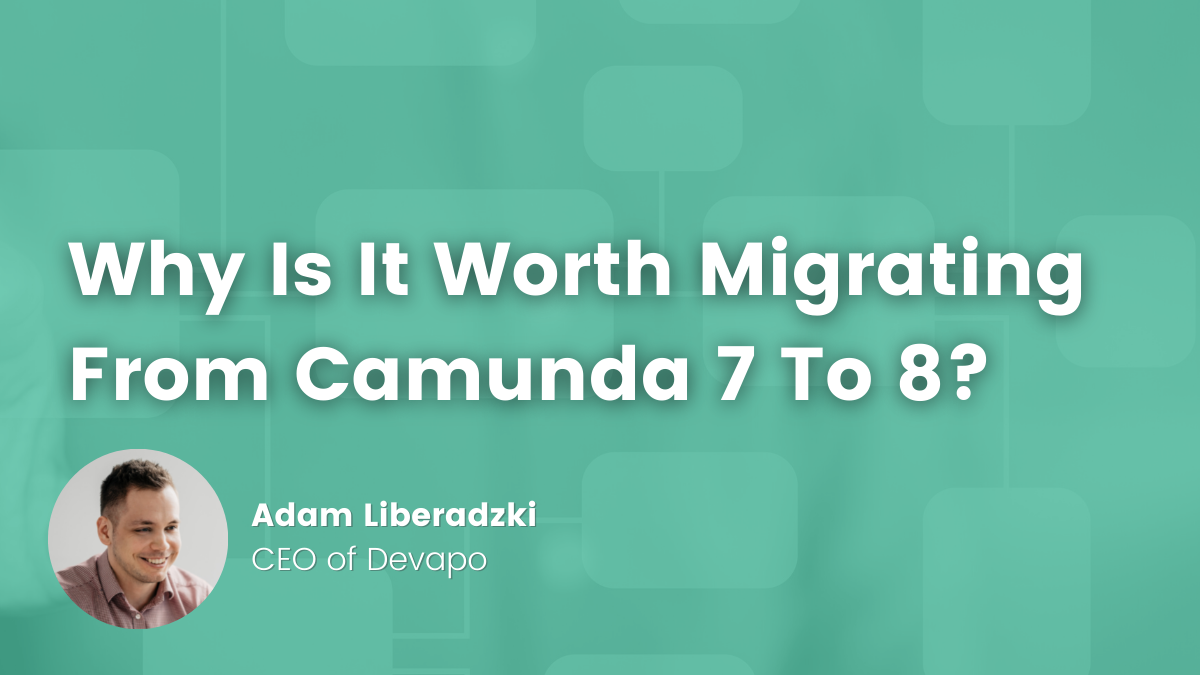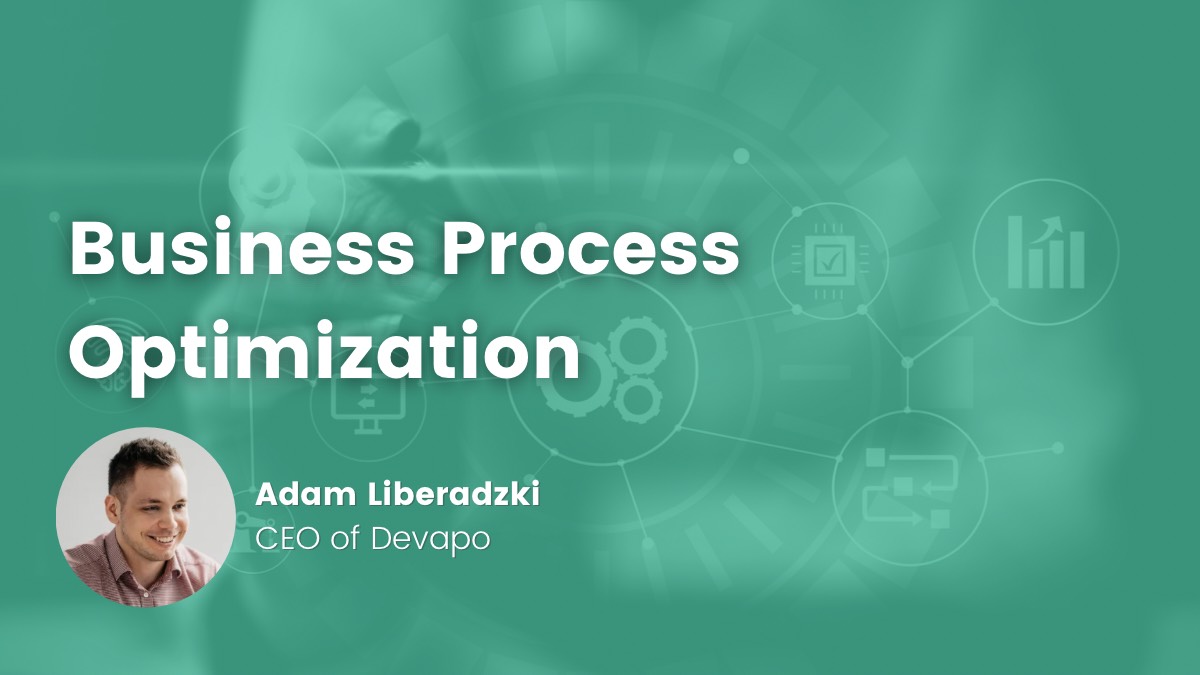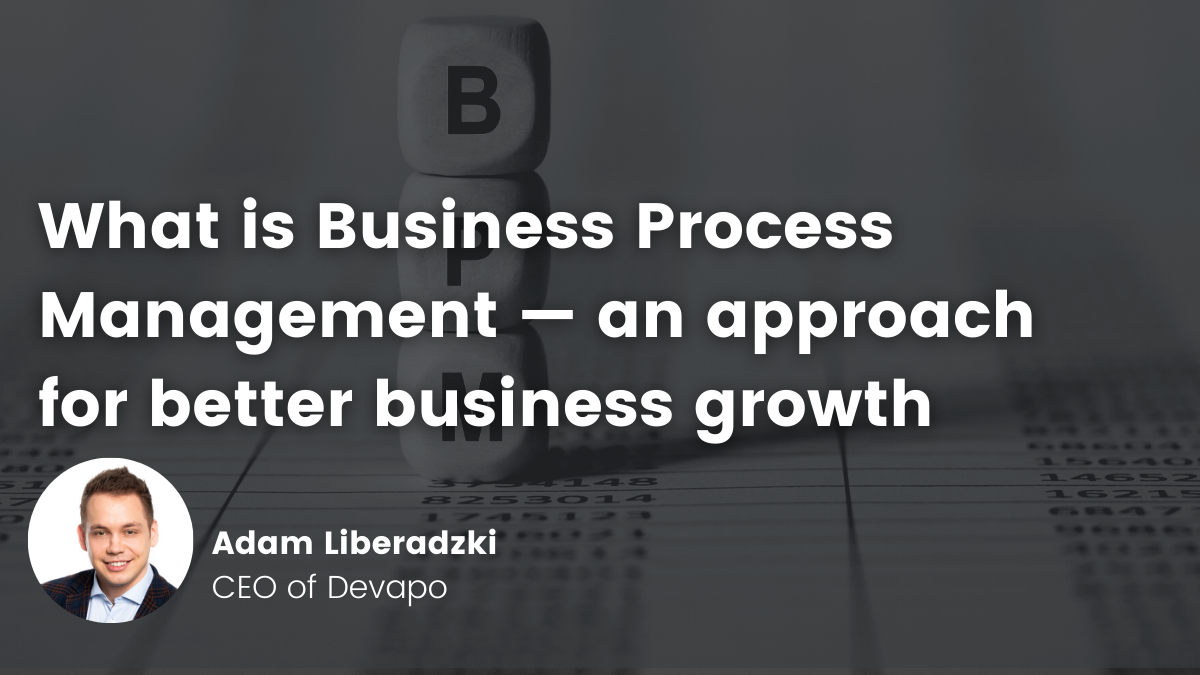- Adam Liberadzki
- Read in 5 min.
Camunda 8 was released in April 2022. Since then, some time has passed, allowing us to see its impact and usefulness through live examples. Therefore, in this article, we will show you why migrating process solutions developed for Camunda Platform 7 to run on Camunda Platform 8 may be important for you.
We’ll outline the main differences between the versions, and you’ll learn about both limitations and advantages of migration. Let’s get started!
Camunda 7 vs Camunda 8 – main differences
Camunda after 9 years since the first release of Camunda 7, has introduced a new version – Camunda Platform 8. The new edition aims to provide a business process automation tool with better solutions and in a newer standard. Let’s zoom in on the main technical differences, which answer global trends and satisfy business and IT needs.
Engine
Universal Process Orchestrator, aka Camunda Platform 8, unlike its predecessor, does not have an embedded engine. The new workflow engine is Zeebe, which is a remote resource for applications.
The business advantage of this solution allows for increased speed, resilience and security, as the engine has cloud native principles. The Zeebe engine uses external task patterns, which decouples the workflow engine from the process. This change in architecture reduces exposure to attacks. The threat of such things is rare in version 7, although it can occur with a bad configuration. (That’s why it’s important to choose the right company to implement the solution, and this applies to any IT system).
With Zeebe’s enterprise-grade resiliency, the risk of downtime or data loss is minimal. The new workflow engine is also more scalable for high-volume use cases than the previous version thanks to horizontal scalability, making it easier to create workflows that can handle data from different sources.
Data storage
One of the biggest differences is that in Camunda 7, data was stored in a relational database. The new version uses an elasticsearch that is specialized on search efficiency, not storage. When one broker goes down, another can replace it, as data is constantly backuping. The data can be exported into a datasource of your choice. Exporter simply takes the data from the Zeebe engine and puts it into elasticsearch.
The biggest advantage over the Camunda 7 is the possibility of better scaling. Storage in a relational database makes eventual transfer much more difficult, time-consuming and expensive in some cases. This happens depending on the complexity of the data model, the number of records you are working on, or the sensitivity of the data. So it’s worth betting on elasticsearch, as you can avoid these situations.
Connectors
Connectors are used to integrate services, reduce the time required to automate and orchestrate business processes in different systems. Camunda Platform 7 offers several Connectors, but this is incomparably less than what Camunda Platform 8 provides. With Camunda 7 it was also harder to create custom connectors, and this issue is solved in Camunda 8. More diversity of connectors allows businesses for faster automation and orchestration of processes across a variety of endpoints.
Independence from programming language
Zeebe’s architecture is based on an external task pattern rather than an in-build one, whereas in Camunda 7 you had a choice between the two. The limitation in this release has a positive impact, as it is now possible to deploy workforce using any programming language that supports gRPC. Camunda itself also provides greater support for other programming languages.

When is it too early to use Camunda 8?
An upgrade can be a smart investment that can boost your business’s growth. So when an opportunity arises to take your company to the next level, you should consider it. A new version of Camunda, means newer standards. However, let’s take a look at situations in which migrating to the latest edition may not be the best idea just yet.
Technology stack – Camunda 8 differs in terms of the technology used from its predecessor. So if you’re not familiar with a different communications protocol and can’t outsource the migration, this may not be the best time. Also if you simply use an embedded engine, you might want to stay with Camunda Platform 7, as in version 8 it has been omitted.
Finances – the cost of migration, depending on the size of the project, can be on the high side. Therefore, if you are currently investing in other solutions, you may want to hold off. However, be sure not to put it off until the last minute, as Camunda 7 won’t be supported forever either. If you don’t know what costs to expect, you can always get a free consultation with us!
Reason – This is probably the most important point. If you have the budget, time capacity and the right skills, it’s still worth asking yourself if you need the features Camunda 8 provides. As we mentioned, supporting Camunda 7 won’t be forever, but ask yourself if you’ll still be using the solution in a few years?
Why migrate to Camunda 8?
Camunda 7 will be maintained and supported for another five years, while Camunda 8 offers expanded technology that will continue to evolve.
Universal Process Orchestrator provides almost unlimited scalability for processes, more independence from programming language, more business capabilities to collaborate in real-time, fast building of forms, very good support for connectors, good troubleshooting tools and many more!
Camunda 8 is here to help you stay ahead of the curve and keep delivering high-quality processes at an affordable cost. New Camunda process engine is designed to run self hosted but also in the cloud, and the new release offers you several opportunities to deploy the system on a service provider’s cloud platform. These include:
- Cloud Foundry
- Heroku
In addition to cloud options, deployment tools that can be leveraged include:
- Kubernetes
- OpenShift
The Camunda platform 8 can be extended in multiple ways, from home-grown extensions to plug-ins, functional extensions and custom solutions by integrating with other applications via APIs. It brings a fresh perspective.
Camunda version 8 enables customers to use the tool in more ways with less effort than ever before. The new features of Camunda 8 make it unnecessary to customize this tool, but rather to develop it. For example, the range of connectors has been greatly expanded, so that customers can quickly build new functionality.
How to perform the migration from Camunda 7 to Camunda 8?
As experienced software engineers and Camunda’s Gold Partner, we are able to perform complex process migrations using different technologies and versions of Camunda solutions. Migration itself is a difficult task that requires extreme care. That’s why we have developed a migration strategy that allows us and our customers to follow the process and check all the boxes to make sure the execution goes smoothly. Here are most of the steps we recommend paying attention to.
- Migrate to remote engine architecture
- Migrate data models with proper serialization
- Review code and focus on so called “clean delegates”
- Migrate listeners, hooks and delegates to use new APIs, depending on your use case
- Refactor scripts and expressions
- Modify BPMN and DMN models
- Take ACID transactions vs eventual consistency into account
- Migrate history and runtime data according to your needs

By following the above guidelines, migrating your project from Camunda Platform 7 to Camunda Platform 8 should go seamlessly and without major code changes.
Summary
Deciding whether to migrate from Camunda 7 to 8 requires careful consideration. At some point, migration will be inevitable, but if any of the situations listed above as blockers apply to you, it is better to postpone the decision.
As an official Camunda Partner, we have the expertise to help you assess whether it’s worth migrating your projects, and to support you in performing the migration effortlessly.
Are you interested in discussing the possibilities of migrating your project?
Book a quick talk!







